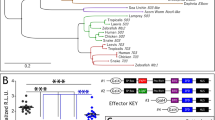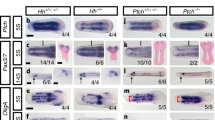Abstract
In the spinal cord, sonic hedgehog (Shh) is secreted by the floor plate to control the generation of distinct classes of ventral neurons along the dorsoventral axis1. Genetic and in vitro studies have shown that Shh also later acts as a midline-derived chemoattractant for commissural axons2. However, the receptor(s) responsible for Shh attraction remain unknown. Here we show that two Robo-related proteins, Boc and Cdon, bind specifically to Shh and are therefore candidate receptors for the action of Shh as an axon guidance ligand. Boc is expressed by commissural neurons, and targeted disruption of Boc in mouse results in the misguidance of commissural axons towards the floor plate. RNA-interference-mediated knockdown of Boc impairs the ability of rat commissural axons to turn towards an ectopic source of Shh in vitro. Taken together, these data suggest that Boc is essential as a receptor for Shh in commissural axon guidance.
This is a preview of subscription content, access via your institution
Access options
Subscribe to this journal
Receive 51 print issues and online access
$199.00 per year
only $3.90 per issue
Buy this article
- Purchase on Springer Link
- Instant access to full article PDF
Prices may be subject to local taxes which are calculated during checkout




Similar content being viewed by others
References
Ericson, J., Muhr, J., Jessell, T. M. & Edlund, T. Sonic hedgehog: a common signal for ventral patterning along the rostrocaudal axis of the neural tube. Int. J. Dev. Biol. 39, 809–816 (1995)
Charron, F., Stein, E., Jeong, J., McMahon, A. P. & Tessier-Lavigne, M. The morphogen sonic hedgehog is an axonal chemoattractant that collaborates with netrin-1 in midline axon guidance. Cell 113, 11–23 (2003)
Tessier-Lavigne, M. & Goodman, C. S. The molecular biology of axon guidance. Science 274, 1123–1133 (1996)
Charron, F. & Tessier-Lavigne, M. Novel brain wiring functions for classical morphogens: a role as graded positional cues in axon guidance. Development 132, 2251–2262 (2005)
Dickson, B. J. Molecular mechanisms of axon guidance. Science 298, 1959–1964 (2002)
Kennedy, T. E., Serafini, T., de la Torre, J. R. & Tessier-Lavigne, M. Netrins are diffusible chemotropic factors for commissural axons in the embryonic spinal cord. Cell 78, 425–435 (1994)
Serafini, T. et al. Netrin-1 is required for commissural axon guidance in the developing vertebrate nervous system. Cell 87, 1001–1014 (1996)
Serafini, T. et al. The netrins define a family of axon outgrowth-promoting proteins homologous to C. elegans UNC-6. Cell 78, 409–424 (1994)
Stone, D. M. et al. The tumour-suppressor gene patched encodes a candidate receptor for Sonic hedgehog. Nature 384, 129–134 (1996)
Kang, J. S., Mulieri, P. J., Hu, Y., Taliana, L. & Krauss, R. S. BOC, an Ig superfamily member, associates with CDO to positively regulate myogenic differentiation. EMBO J. 21, 114–124 (2002)
Kang, J. S., Mulieri, P. J., Miller, C., Sassoon, D. A. & Krauss, R. S. CDO, a robo-related cell surface protein that mediates myogenic differentiation. J. Cell Biol. 143, 403–413 (1998)
Mulieri, P. J., Okada, A., Sassoon, D. A., McConnell, S. K. & Krauss, R. S. Developmental expression pattern of the cdo gene. Dev. Dyn. 219, 40–49 (2000)
Mulieri, P. J., Kang, J. S., Sassoon, D. A. & Krauss, R. S. Expression of the boc gene during murine embryogenesis. Dev. Dyn. 223, 379–388 (2002)
Connor, R. M., Allen, C. L., Devine, C. A., Claxton, C. & Key, B. BOC, brother of CDO, is a dorsoventral axon-guidance molecule in the embryonic vertebrate brain. J. Comp. Neurol. 485, 32–42 (2005)
Cole, F. & Krauss, R. S. Microform holoprosencephaly in mice that lack the Ig superfamily member Cdon. Curr. Biol. 13, 411–415 (2003)
Ming, J. E. & Muenke, M. Holoprosencephaly: from Homer to Hedgehog. Clin. Genet. 53, 155–163 (1998)
Muenke, M. & Beachy, P. A. Genetics of ventral forebrain development and holoprosencephaly. Curr. Opin. Genet. Dev. 10, 262–269 (2000)
Lum, L. et al. Identification of Hedgehog pathway components by RNAi in Drosophila cultured cells. Science 299, 2039–2045 (2003)
Yao, S., Lum, L. & Beachy, P. The ihog cell-surface proteins bind Hedgehog and mediate pathway activation. Cell 125, 343–357 (2006)
Zhang, W., Kang, J. S., Cole, F., Yi, M. J. & Krauss, R. S. Cdo functions at multiple points in the Sonic Hedgehog pathway, and Cdo-deficient mice accurately model human holoprosencephaly. Dev. Cell 10, 657–665 (2006)
Tenzen, T. et al. The cell surface membrane proteins Cdo and Boc are components and targets of the Hedgehog signaling pathway and feedback network in mice. Dev. Cell 10, 647–656 (2006)
Friedel, R. H. et al. Gene targeting using a promoterless gene trap vector (‘targeted trapping’) is an efficient method to mutate a large fraction of genes. Proc. Natl Acad. Sci. USA 102, 13188–13193 (2005)
Sabatier, C. et al. The divergent Robo family protein rig-1/Robo3 is a negative regulator of slit responsiveness required for midline crossing by commissural axons. Cell 117, 157–169 (2004)
Keino-Masu, K. et al. Deleted in Colorectal Cancer (DCC) encodes a netrin receptor. Cell 87, 175–185 (1996)
Long, H. et al. Conserved roles for Slit and Robo proteins in midline commissural axon guidance. Neuron 42, 213–223 (2004)
Marigo, V., Davey, R. A., Zuo, Y., Cunningham, J. M. & Tabin, C. J. Biochemical evidence that patched is the Hedgehog receptor. Nature 384, 176–179 (1996)
Chuang, P. T. & McMahon, A. P. Vertebrate Hedgehog signalling modulated by induction of a Hedgehog-binding protein. Nature 397, 617–621 (1999)
Cheng, H. J. & Flanagan, J. G. Cloning and characterization of RTK ligands using receptor-alkaline phosphatase fusion proteins. Methods Mol. Biol. 124, 313–334 (2001)
Okada, A., Lansford, R., Weimann, J. M., Fraser, S. E. & McConnell, S. K. Imaging cells in the developing nervous system with retrovirus expressing modified green fluorescent protein. Exp. Neurol. 156, 394–406 (1999)
Mitchell, K. J. et al. Functional analysis of secreted and transmembrane proteins critical to mouse development. Nature Genet. 28, 241–249 (2001)
Acknowledgements
We thank L. Luo, A. O’Reilly, M. Scott and K. Shen for critically reading the manuscript; C. Jolicoeur and H. Rayburn for the generation of chimaeric mice; C. Kaznowski for technical assistance; R. Krauss, J. Zhang, M. Scott, H. Tian and F. de Sauvage for discussions during early stages of the project; and T. Rando for supporting A.O. during the writing of the manuscript. This work was supported by grants from the National Institute of Mental Health and American Cancer Institute to A.O., the National Eye Institute to S.K.M., the National Institute of Mental Health to M.T.L. and S.K.M., and the Arnold and Mabel Beckman Foundation, the Fonds de Recherche en Santé du Québec (FRSQ), the Canadian Institutes of Health Research (CIHR) and the Peter Lougheed Medical Research Foundation to F.C.
Author information
Authors and Affiliations
Corresponding author
Ethics declarations
Competing interests
Reprints and permissions information is available at www.nature.com/reprints. The authors declare no competing financial interests.
Supplementary information
Supplementary Notes
This file contains Supplementary Figures 1–6 and Supplementary Methods (PDF 4841 kb)
Rights and permissions
About this article
Cite this article
Okada, A., Charron, F., Morin, S. et al. Boc is a receptor for sonic hedgehog in the guidance of commissural axons. Nature 444, 369–373 (2006). https://doi.org/10.1038/nature05246
Received:
Accepted:
Published:
Issue Date:
DOI: https://doi.org/10.1038/nature05246
This article is cited by
-
Ihog proteins contribute to integrin-mediated focal adhesions
Science China Life Sciences (2023)
-
Corticospinal-specific Shh overexpression in combination with rehabilitation promotes CST axonal sprouting and skilled motor functional recovery after ischemic stroke
Molecular Neurobiology (2023)
-
SLITRK5 is a negative regulator of hedgehog signaling in osteoblasts
Nature Communications (2021)
-
Emerging roles of the Hedgehog signalling pathway in inflammatory bowel disease
Cell Death Discovery (2021)
-
Ptch2/Gas1 and Ptch1/Boc differentially regulate Hedgehog signalling in murine primordial germ cell migration
Nature Communications (2020)
Comments
By submitting a comment you agree to abide by our Terms and Community Guidelines. If you find something abusive or that does not comply with our terms or guidelines please flag it as inappropriate.



